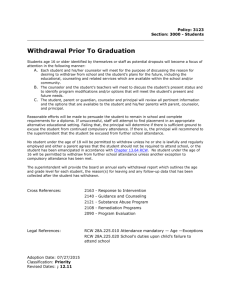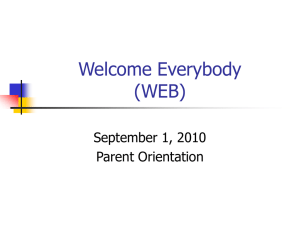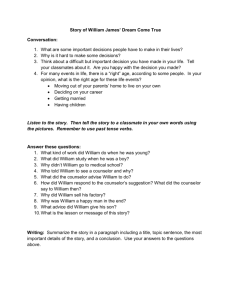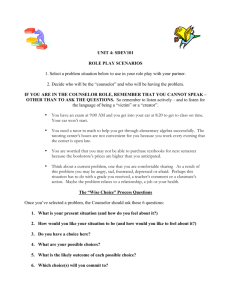West Virginia School Counseling Protocol Attendance K‐12
advertisement
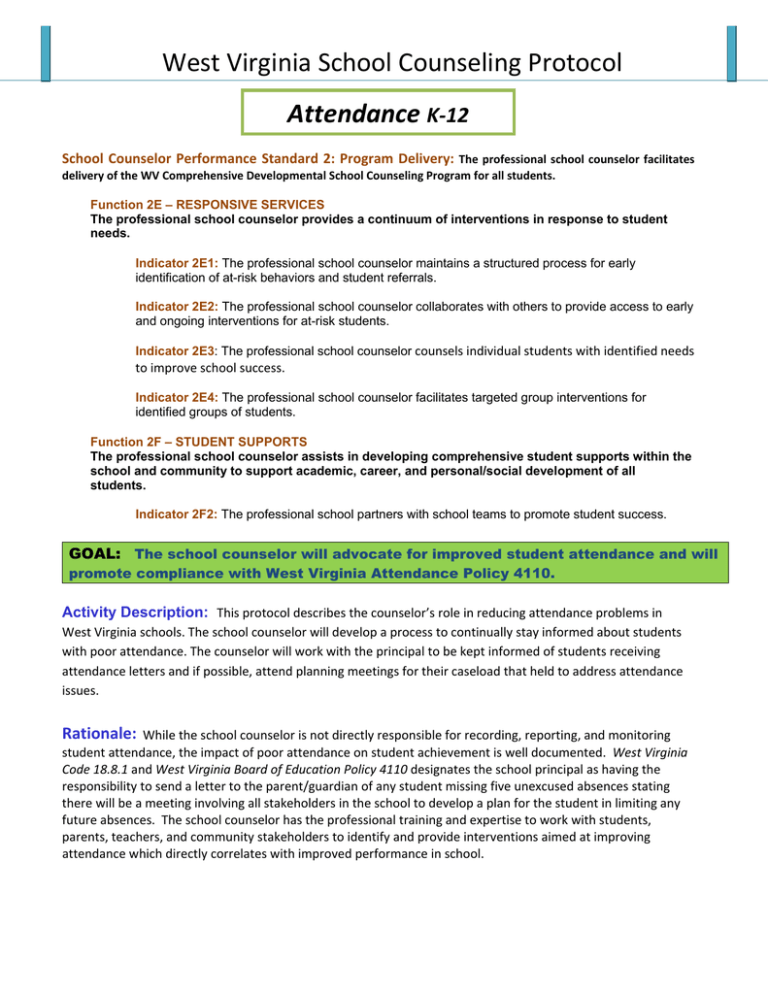
West Virginia School Counseling Protocol Attendance K‐12 School Counselor Performance Standard 2: Program Delivery: The professional school counselor facilitates delivery of the WV Comprehensive Developmental School Counseling Program for all students. Function 2E – RESPONSIVE SERVICES The professional school counselor provides a continuum of interventions in response to student needs. Indicator 2E1: The professional school counselor maintains a structured process for early identification of at-risk behaviors and student referrals. Indicator 2E2: The professional school counselor collaborates with others to provide access to early and ongoing interventions for at-risk students. Indicator 2E3: The professional school counselor counsels individual students with identified needs to improve school success. Indicator 2E4: The professional school counselor facilitates targeted group interventions for identified groups of students. Function 2F – STUDENT SUPPORTS The professional school counselor assists in developing comprehensive student supports within the school and community to support academic, career, and personal/social development of all students. Indicator 2F2: The professional school partners with school teams to promote student success. GOAL: The school counselor will advocate for improved student attendance and will promote compliance with West Virginia Attendance Policy 4110. Activity Description: This protocol describes the counselor’s role in reducing attendance problems in West Virginia schools. The school counselor will develop a process to continually stay informed about students with poor attendance. The counselor will work with the principal to be kept informed of students receiving attendance letters and if possible, attend planning meetings for their caseload that held to address attendance issues. Rationale: While the school counselor is not directly responsible for recording, reporting, and monitoring student attendance, the impact of poor attendance on student achievement is well documented. West Virginia Code 18.8.1 and West Virginia Board of Education Policy 4110 designates the school principal as having the responsibility to send a letter to the parent/guardian of any student missing five unexcused absences stating there will be a meeting involving all stakeholders in the school to develop a plan for the student in limiting any future absences. The school counselor has the professional training and expertise to work with students, parents, teachers, and community stakeholders to identify and provide interventions aimed at improving attendance which directly correlates with improved performance in school. WV K-12 Attendance Protocol Materials: 1. 2. 3. 4. West Virginia School Law; 18‐8‐5. Compulsory School Attendance Duties of principal, administrative head or other chief administrator. West Virginia Board of Education, Policy 4110 Group Counseling Lessons http://wvde.state.wv.us/counselors/group‐lessons.html Procedures: 1. The school counselor becomes familiar with their county’s attendance policy and is aware of the school’s process in notifying and working with students who have truancy issues. 2. The counselor communicates with the principal and asks to be provided (on a regular basis) the list of truant students as developed and shared by the attendance director in compliance with West Virginia Code 18.8.1 and West Virginia Board of Education Policy 4110. 3. The school counselor develops a working relationship with the school/county attendance director to assure they have ongoing communication regarding students who have truancy issues. 4. At the beginning of each school year, or the summer prior to school starting (when the counselor is on an extended contract), the counselor identifies students with prior truancy issues in conjunction with feeder school counselors and attendance directors. 5. The school counselor is part of the school team and is informed when students miss five unexcused days. Students receive a letter from the principal to participate in a planning meeting on how the school, parent(s), and student are going to minimize future absences and address any deficits that may have occurred through student support services. 6. The counselor establishes a process for monitoring students at‐risk for truancy. 7. The school counselor annually provides professional development to school staff regarding a referral process for counseling and the SAT Team. 8. The counselor makes referrals, as needed, to the SAT Team for students with truancy issues. 9. The school counselor participates on the SAT Team for referred students in his/her caseload and helps the team design interventions to support truant students, as noted in the Student Support Teams Protocol. 10. The school counselor participates in the planning process to address the needs of students who because of attendance issues are academically deficit. 11. As appropriate, the counselor facilitates prevention‐based interventions with truant students that may include classroom guidance, individual and group counseling, or referral of students to relevant school and community resources. 12. The school counselor assists teachers/advisors and administrators with staying in contact with truant students and families, especially if there are changes in attendance, behavior, or grades. 2 Lead Protocol Developer: Rebecca Derenge, Coordinator, OIEP – Protocol approved June, 2010 WV K-12 Attendance Protocol 13. When there is a homeroom base or student advisory program in place, the school counselor works closely with the homeroom teacher/advisor to assure parents are being informed of ongoing attendance issues. 14. The school counselor assists students with truancy issues in receiving in‐school or after‐school tutoring, or other academic supports. 15. When appropriate, the counselor involves affected students in individual and/or group counseling sessions relevant to issues contributing to the truancy issues (school phobia, family issues, academic issues, poor social skills, bullying, health issues, and lack of motivation). Resources: West Virginia School Law; 18‐8‐5. Compulsory School Attendance Duties of principal, administrative head or other chief administrator. “It shall be the duty of the principal, administrative head or other chief administrator of each school, whether public or private, to make prompt reports to the county attendance director, or proper assistant, of all cases of unexcused absences arising within the school which require the services of an attendance worker. Such reports shall be on the form prescribed for such purpose, by telephone, or in person, and shall include essential information about the child and the name and residence of any parent, guardian or custodian of a child.” “It shall also be the duty of each principal, administrative head or other chief administrator of each public school to ascertain the report promptly the name of any parent, guardian or custodian of any child of compulsory school age as defined in this article who was or should be enrolled in the school reporting and who has not enrolled in any school that year. By way of ascertaining the status of school attendance, each principal, administrative head or other chief administrator shall compare the school census with the school enrollment at the opening of the school term and each month thereafter, or as directed by the county superintendent of schools, and report the same to the county attendance director: Provided, That any child who was or should be enrolled in a particular school, but who is at the time enrolled in another school shall be considered as attending the school in which enrolled and shall be included only in the report of attendance from the school in which the child is enrolled at the time.” “If the principal, administrative head or other chief administrator of a school determines that an enrolled pupil has accumulated unexcused absences from attendance at such school for five instructional days during any one half of the instructional term, the principal, administrative head or other chief administrator shall contact any parent, guardian or custodian of the pupil and shall hold a meeting with any person so contacted, and the pupil, and any other person that the administrator deems a relevant participant in such meeting.” West Virginia Board of Education, Policy 4110 b. In the case of five consecutive or five (5) (new language 2010) total unexcused absences of a child during a school year, the attendance director or his/her assistant shall serve written notice to the parent, guardian, or custodian of such child that the attendance of such child at school is required and that within ten (10) days; the time frame as specified in W. Va. Code §18‐8‐4(b) of receipt 3 Lead Protocol Developer: Rebecca Derenge, Coordinator, OIEP – Protocol approved June, 2010 WV K-12 Attendance Protocol of the notice the parent, guardian, or custodian, accompanied by the child, shall report in person to the school the child attends for a conference with the principal, or other designated representative of the school in order to discuss and correct the circumstances causing the unexcused absences of the child. Evaluation: Student attendance improves, attendance reports, letters to parents, counselor intervention logs, dropout rate decreases, and more people are vested in attendance of all students. 4 Lead Protocol Developer: Rebecca Derenge, Coordinator, OIEP – Protocol approved June, 2010
